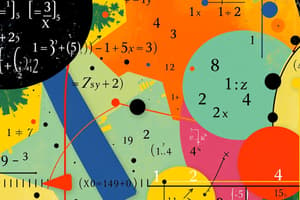Podcast
Questions and Answers
What percentage of the exam focuses on Algebraic Reasoning?
What percentage of the exam focuses on Algebraic Reasoning?
- 70%
- 55% (correct)
- 30%
- 45%
What type of mathematical operations are involved in problems with ratios and proportions?
What type of mathematical operations are involved in problems with ratios and proportions?
- Fractions and decimals
- Exponents and roots
- Addition and subtraction
- Multiplication and division (correct)
What is the primary focus of the Quantitative Reasoning section?
What is the primary focus of the Quantitative Reasoning section?
- Calculus and differential equations
- Algebraic expressions and equations
- Data analysis and statistics (correct)
- Geometry and trigonometry
What mathematical concept involves finding unknown values in equations?
What mathematical concept involves finding unknown values in equations?
What type of mathematical object is often graphed in Algebraic Reasoning?
What type of mathematical object is often graphed in Algebraic Reasoning?
What set of numbers includes all natural numbers and their negative counterparts?
What set of numbers includes all natural numbers and their negative counterparts?
What is the term for a statement that one expression is greater than, less than, or equal to another?
What is the term for a statement that one expression is greater than, less than, or equal to another?
What is the term for a location in space, represented by coordinates (x, y)?
What is the term for a location in space, represented by coordinates (x, y)?
What is the term for the study of counting and arranging objects in different ways?
What is the term for the study of counting and arranging objects in different ways?
What is the term for the rate of change of a function with respect to the input?
What is the term for the rate of change of a function with respect to the input?
What is the term for summarizing and describing data?
What is the term for summarizing and describing data?
What is the term for a non-repeating, non-terminating decimal?
What is the term for a non-repeating, non-terminating decimal?
What is the term for the study of graphs, which consist of nodes and edges?
What is the term for the study of graphs, which consist of nodes and edges?
Flashcards are hidden until you start studying
Study Notes
Quantitative Reasoning
- Covers 45% of the exam
- Involves problems with:
- Positive and negative whole numbers
- Decimals
- Fractions
- Also includes:
- Ratios
- Proportions
- Percents
- Data and statistics
- Geometric measurement
Algebraic Reasoning
- Covers 55% of the exam
- Involves:
- Expressions
- Polynomials
- Equations
- Inequalities
- Linear equations
- Quadratic equations
- Patterns and functions
- A variety of formats assess:
- Evaluating skills
- Solving skills
- Graphing skills in algebra
Numbers
- Natural Numbers: start from 1 and go on indefinitely, example: 1, 2, 3, ...
- Whole Numbers: include 0 and natural numbers, example: 0, 1, 2, 3, ...
- Integers: include whole numbers and their negative counterparts, example: ..., -3, -2, -1, 0, 1, 2, 3, ...
- Rational Numbers: can be expressed as a ratio of integers, example: 3/4, 22/7
- Irrational Numbers: cannot be expressed as a ratio of integers, example: π, e
- Real Numbers: include both rational and irrational numbers
Algebra
- Variables: represent unknown values and are denoted by letters or symbols
- Constants: are numbers that do not change value
- Expressions: are combinations of variables, constants, and mathematical operations
- Equations: are statements that two expressions are equal
- Inequalities: are statements that one expression is greater than, less than, or equal to another
Geometry
- Points: are locations in space, represented by coordinates (x, y)
- Lines: are sets of points that extend infinitely in two directions
- Rays: are lines that extend infinitely in one direction
- Angles: are formed by two rays sharing a common endpoint
- Triangles: are three-sided shapes with three vertices and three sides
Calculus
- Limits: describe the behavior of a function as the input approaches a certain value
- Derivatives: measure the rate of change of a function with respect to the input
- Integrals: calculate the accumulation of a function over a given interval
- Applications: include optimization, physics, engineering, economics, and more
Statistics
- Descriptive Statistics: summarize and describe data
- Measures of central tendency: include mean, median, and mode
- Measures of variability: include range, variance, and standard deviation
- Inferential Statistics: make inferences about a population based on a sample
- Hypothesis testing: test a claim about a population
- Confidence intervals: estimate a population parameter
Other Topics
- Graph Theory: studies graphs, which consist of nodes and edges
- Combinatorics: studies counting and arranging objects in different ways
- Probability: studies chance and randomness
Studying That Suits You
Use AI to generate personalized quizzes and flashcards to suit your learning preferences.




